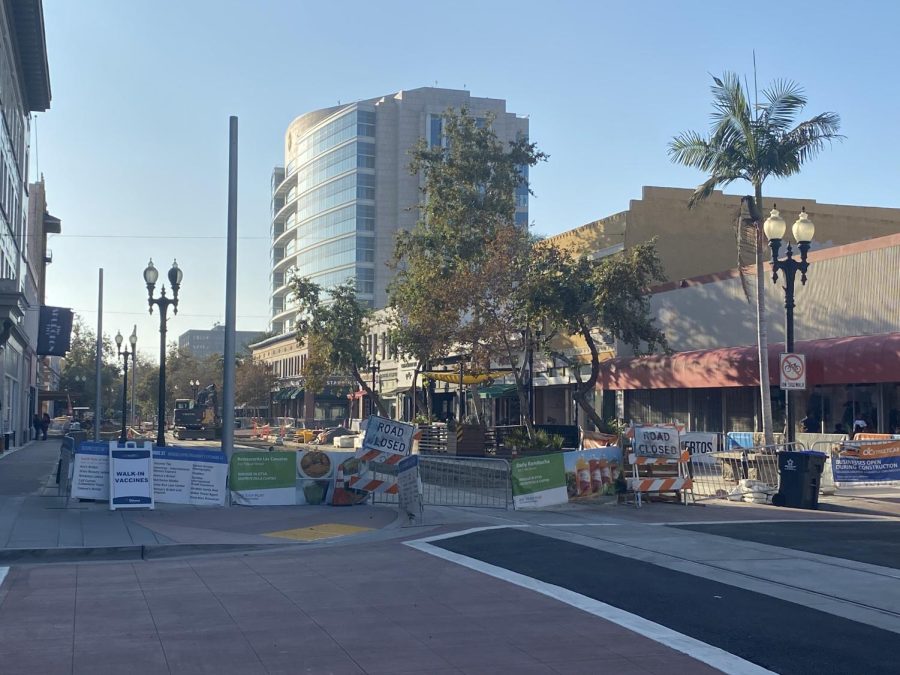Gentrification is changing Santa Ana
Courtesy of Evelyn Herrera
Construction in downtown Santa Ana continues on Fourth Street as of Tuesday, October 11th.
October 27, 2022
On September 24, 2018, the Orange County Transportation Authority announced the creation of the OC Streetcar, a transportation system meant to decrease traffic congestion and link the downtown sector of the city of Santa Ana to shopping centers in adjacent cities such as Garden Grove and Orange. At the core of the construction frenzy lay the iconic 4th street of Santa Ana, known for its Hispanic atmosphere largely due to the plethora of quinceañera shops, its Mexican food, and the multiple candy locales dotted throughout the street.
Considered a “revitalization of the economy” by increasing transit to the historical sector of Santa Ana, the OC Streetcar project was announced to begin construction in 2020 and has received nearly $509 million in funding from both the federal and local governments. Originally planned to finish construction by late 2021, the construction of the project was delayed as a result of the COVID-19 pandemic.
With construction continuing once more, the project originally meant to help has posed a problem to the overall health of the economy of the downtown area because of delays in construction that have resulted in the closing of many key roads. Frequently used roads such as Main Street, Broadway, and 4th Street have been closed in order to help with construction, which has resulted in considerable problems for business owners and residents of the area. In a recent interview, Miguel Gonzalez-Rosas (12), a Segerstrom student, voiced his perspective on the issue.
“I think the construction on Fourth street is affecting the city of Santa Ana by inconveniencing not only local businesses but also local residents. I know many people who’ve had to change their entire daily routine and bus routes because of the construction. I feel it’s just been unconventional and a nuisance to people living around the area to make so many detours.”
The city’s steps to continue gentrification of the downtown sector of the city have shown other significant consequences. Many renters have noticed an increase in rent resulting from landlords attempting to capitalize on gentrification. In turn, this has resulted in an increase in the homeless population due to renters being unable to afford homes due to increasing prices.
“I think it was really inconsiderate of the local government to give so much funding to create a trolley system that wasn’t really necessary. The acts of the transportation authority were careless and didn’t really consider the residents and business owners of 4th street who could’ve used the money more. Now, many of the businesses I once went to are closing because they can’t afford to pay rent. Instead of spending all that money on a trolley, they could’ve used it for more affordable housing or government programs,” Gonzalez added.
Although the construction continues to negatively impact the city, many positive outcomes have also been projected. Santa Ana resident Henry Lopez (12) reacted differently to the construction.
“I feel that this is a great thing for our city. Our city doesn’t really have the best streets or environmentally friendly ideas, unlike many other places I’ve been to. I think it’s an amazing idea to make our city look nicer. It’s totally worth it sacrificing a little traffic in order to make the city which I’ve lived in since I was a kid better so it can compete with neighboring cities.”
With many differing views on the logistics of the project, the construction on Fourth Street continues to open the door to bigger and bolder projects. The street is now filled with more modern and appealing buildings, such as bars, clubs, and restaurants with different cuisine from all over the world.
As the construction on Fourth street continues with a projected end date of sometime in 2023, residents and business owners of the area can only wait and see what the project has in store for the future of downtown Santa Ana.

